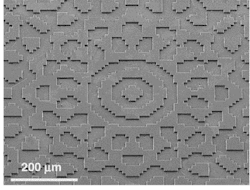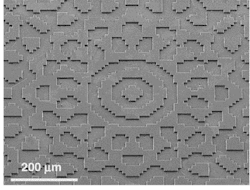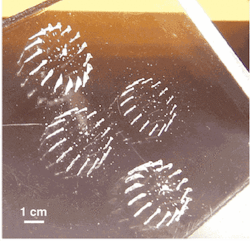Diamond is a machinist's best friend
High-power carbon-dioxide (CO2) lasers place great demands on beam-shaping optics. If even a small fraction of a high-power beam is absorbed in an optical element, a large thermally induced expansion can result, causing thermal lensing and potentially fracturing the element. In the conventional solution, zinc selenide (ZnSe)—which has an optical absorption coefficient of 0.0005 cm-1 at the 10.6-µm CO2 wavelength—minimizes thermal expansion by keeping the element's absorbed power low.
In a second approach, taken by researchers at Uppsala University (Uppsala, Sweden), diamond—which has a much higher absorption coefficient of 0.03 to 0.1 cm-1—minimizes thermal expansion by taking advantage of diamond's high thermal conductivity of 1900 to 2200 W/mK (vs. 16 to 18 W/mK for ZnSe) and its low thermal-expansion coefficient of 1 × 10-6/K (vs. 7.1 × 10-6/K for ZnSe). These and other properties of diamond make the material a better choice than ZnSe for diffractive beam-shaping optics used in materials processing, say the Uppsala researchers.
For example, not only is diamond 80 times harder than ZnSe and 100,000 times more resistant to sand erosion, it is also unaffected by concentrated acids, to which ZnSe is susceptible. Materials processing, including cutting and welding, often takes place in—or creates—an erosive, caustic environment.
null
The researchers have fabricated binary fanout diffractive optical elements (DOEs) from diamond for use with CO2 lasers, as well as for use with HeNe lasers for test purposes (see Fig. 1). The fabrication was done by contact photolithography and plasma etching of 10-mm-diameter, 0.3-mm-thick polycrystalline diamond substrates. Because the whole substrate is structured, the laser beam can strike the DOE anywhere and still produce the desired beam fanout.
A test on a DOE designed for a 633-nm HeNe laser beam showed that virtually all the light went into the proper diffraction orders, with only a faint zero-order spot observed. When a 543-nm He-Ne laser was used, the zero-order spot became very apparent, as expected. In both cases, the fanout spots were uniform to about 4%. Variations in feature depth on the DOE affect diffraction efficiency but don't affect spot-to-spot uniformity, say the researchers.
"The depth deviation was around 3% to 5% for both the 633-nm element and the 10.6-µm element," says Fredrik Nikolajeff, one of the researchers. "Of course, the depth might vary over the whole surface; we did not carry out any thorough investigation of this so the numbers are more to be considered as indicative. On the other hand, a larger depth deviation would have showed up in a less optimal diffraction pattern, so we are quite confident about the accuracy of the etching process."
null
The DOE designed for CO2 laser radiation was also tested, with a single-transverse-mode CO2 laser beam passing through the DOE and into a 10-mm-thick polymethylmethacrylate (PMMA) plate (see Fig. 2). In this case, characteristics of the DOE design caused four spurious low-intensity spots close to the zero order, with corresponding small holes in the PMMA. The researchers next intend to create diamond DOEs with continuous relief rather than a binary phase-relief pattern to increase diffraction efficiency.
REFERENCE
- M. Karlsson and F. Nikolajeff, Optics Express 11(3), 191 (Feb. 10, 2003).


